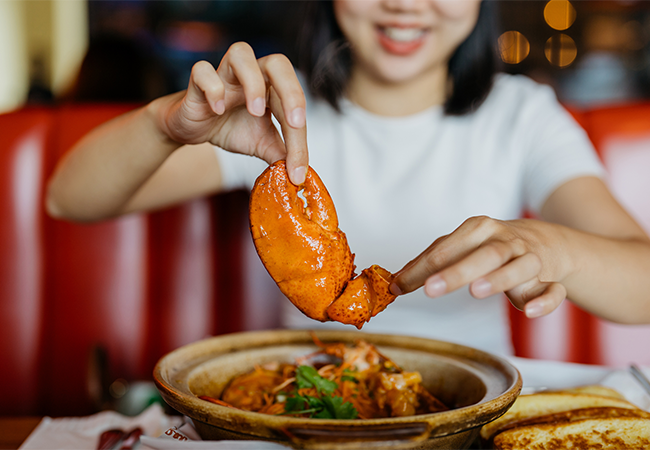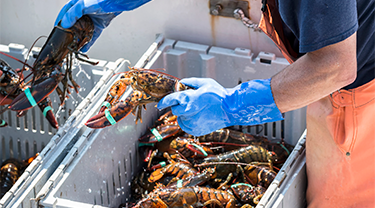Why the Indo-Pacific is such a good catch
If you’re looking to develop your markets beyond North America, you can’t afford to ignore the biggest growth region of all: The Indo-Pacific. Raw population numbers aside—around four billion people—it’s the way this geographic collection of 40 markets is evolving that has businesses seriously revising their expansion strategies. The region’s middle-class growth trajectory is staggering, and by 2030, it’ll be home to two-thirds of the global middle class.
By and large, Canadian seafood companies don’t have to be lured to the Indo-Pacific; many of them are already there, thriving, and looking to expand their reach. The No. 1 destination for Canadian seafood outside of the United States is China—by a huge margin—and volumes to that market have increased steadily over the last several years.
Beyond China, other key Indo-Pacific markets for our seafood exports include Japan, South Korea, Hong Kong, Vietnam and Taiwan, based on a report by Fisheries and Oceans Canada. On top of those more established markets is a new layer of emerging opportunities in Indonesia and the Philippines. There are also long-play possibilities such as India that could lead to near-limitless demand once they’re established.
The Indo-Pacific is a complex tapestry of different languages, cultures, religions, consumer preferences, regulatory regimes, and economic and political structures. While the whole region offers much potential, you’ll need to consider each market separately and perform the required due diligence prior to market entry. Achieving success in one market offers the potential of complementary learnings, but it’s not a guarantee of success in your next endeavour.
For that, you’ll need to immerse yourself in market intelligence, including observations from some of the key sector players who’ve found success in the Indo-Pacific, and are looking to cast an even wider net in the region. Consider this a quick primer on how to start thinking strategically about this market for your own expansion.
What’s on the menu? A look at supply and demand.
Whether it’s wild Pacific salmon from British Columbia, lobster from the Atlantic provinces, halibut from Nunavut, or crab from Quebec, the opportunities for Canadian seafood providers—for both wild seafood and aquaculture—flows from sea to sea to sea.
| Canada’s top 5 fish and seafood exports by species (2021)* |
|---|
|
1. Lobster: $3.26 billion 2. Crab: $2.18 billion 3. Salmon: $1.12 billion 4. Shrimp/prawn: $388 million 5. Halibut: $221 million |
| Canadian fish and seafood export values to top 5 Indo-Pacific destinations (2021)* |
|---|
|
1. China: $1.12 billion 2. Japan: $249 million 3. Hong Kong: $166 million 4. South Korea: $129 million 5. Vietnam: $43 million |
Trends to watch
Long recognized for its nutrient-rich properties, seafood is gaining popularity with consumers for a variety of reasons. According to Edward Steeves, Export Development Canada’s (EDC) regional vice-president for the Atlantic region, five key trends are converging to accelerate demand:
- Alternative protein demand: The desire for alternative sources of protein has driven a long-term upward trend in the value of seafood exports that’s expected to continue as the world strives to feed itself.
- Exponential rise of middle class: As the middle class continues its outsized growth in the Indo-Pacific, the demand for premium Canadian seafood is poised to rise proportionately.
- Rise of frozen food options: While COVID-19 negatively impacted the food service industry, it led to a surge in frozen seafood options available at the retail level, and a commensurate self-serve demand by consumers that has endured post-pandemic.
- Rebound of food service industry: People are returning to restaurants in the wake of the pandemic, exhibiting their pent-up demand for high-end seafood.
- Growth of aquaculture: Finite wild fish and seafood stocks, coupled with government quotas aimed at preventing over-fishing, have led to a growth in aquaculture solutions that’ll continue to accelerate alongside the demand for alternative, affordable protein.
Brand Canada and other advantages
“Canadian seafood is synonymous with quality and freshness. Recognized the world over as a premium brand, many of our highest-priced seafood delicacies are coveted not only for their taste, but as culinary status symbols in the Indo-Pacific,” says Ashley Kanary, director of global agri-food at EDC.
As the middle class continues to rise in the region—along with concerns about food safety and sustainability—so will the desire for Canadian seafood. The sector has the potential to grow its exports by catering to and building consumer tastebuds. Product innovations—from environmentally conscious packaging to low-prep, latest-taste offerings—will feed into the demands of consumers looking for simplicity, variety, and the next new thing.
The sector’s environmental, social and governance (ESG) practices get high marks, as does its efforts to become even more focused on sustainability and boat-to-plate traceability. Technological advancements are turning traditional fishing vessels into massive, state-of-the-art, flash-frozen-at-sea facilities, with little, if any, waste.
Currently, there are two free trade agreements (FTA) in place—the Comprehensive and Progressive Agreement for Trans-Pacific Partnership (CPTPP) and the Canada-Korea Free Trade Agreement (CKFTA)—that provide Canadian exporters with preferential access to eight Indo-Pacific nations. Negotiations are underway to solidify more FTAs within the next few years.

Shoals to navigate
Counterfeit product—while a nod to Canadian producers’ brand recognition in market—is a leading problem in the region. Clearwater’s been plagued by knockoff products from North Korea, and there are similar stories voiced by other top seafood brands selling into the Indo-Pacific.
While Brand Canada is well-entrenched in the region, we compete with strong challengers from the U.S. and Europe. Scandinavian countries are huge seafood producers with highly structured and efficient production capabilities. Physically closer to the Indo-Pacific, their shipping costs are considerably lower, and they have the ability to process in different countries that are closer to the end market.
Logistics and supply chain issues pose considerable hurdles given the sheer distance between Canada and the Indo-Pacific. Premium seafood is typically delivered live via air freight, adding significantly to the final cost. Frozen seafood has to withstand the complex distribution process—from main port of entry to supermarket shelves or restaurant tables. No matter how amazing the quality, there’s a threshold on what consumers are willing to pay. That sentiment can vary widely in any given year, and with it, the prices that Canadian producers can yield.
Exporter insights on the Indo-Pacific
In an effort to better understand the experiences of Canadian exporters in the Indo-Pacific, EDC reached out to a number of agri-food producers, including a sizable contingent of seafood companies. Their input was invaluable, offering a candid look at where they’re finding success, and what they need in order to achieve greater market penetration.
Interestingly enough, the conversations with all of these exporters echoed five key themes.
1. Next-level buyer introductions
Seafood exporters are looking for that deeper layer of buyer intelligence. They’ve already secured solid relationships with the biggest buyers in one country; now, they’re looking for warm introductions to the Tier 2 buyers there, and in neighbouring countries. Because many Canadian seafood companies are selling to the same larger buyers, there’s an urgent need to build out the size of the pie.
2. Over-reliance on China
With the bulk of their seafood volumes going to China, Canadian exporters recognize the need to diversify within the Indo-Pacific. While they’re comfortable with their current levels of exposure in China, they’re looking to grow their share of alternative markets in the region; and by that, they mean at least four markets deep—if not more. In order to pivot to new countries, they’re looking for serious market intelligence that verifies key indicators, like consumer demand, the competitive landscape, and the buyers they can trust in these vastly different markets.
3. Geopolitical shifts and unforeseen consequences
Sanctions and other geopolitical events can quickly change the supply-demand equation in countries that are both directly and indirectly affected, accelerating the need for further market diversification. For example, when Russia launched its illegal war on Ukraine, many democratic nations invoked sanctions, resulting in a tangential shift in Russian seafood market dynamics. Their response was to flood non-sanctioning countries with seafood at a discounted price, which pushed out some Canadian companies.
4. Demand creation: Identifying potential market niches
Canadian seafood exporters are aggressively looking for new lures to cast in the region in the form of pilot entries, to build the brand and test the waters. Identifying and nurturing potential niches are key steps. What might this look like? Take lobster in India, for example. There’s no demand now—but take their rising middle class, baste it with the right marketing campaign, and you could end up with a whole new market segment. Identifying potential entry points would be the next step: In this case, convincing large Indian hotel chains that cater to Western lifestyle-seeking clients to put Canadian lobster on their menus.
5. Essential peace of mind provided by EDC Credit Insurance
It’s a sentiment voiced by all exporters to the Indo-Pacific: They simply wouldn’t consider entering or expanding throughout the region without having our credit insurance in place. As a rule, Canadian companies are hesitant to take on new buyer risk without EDC’s support to mitigate the risk. It’s gratifying to hear, but I think there are many more ways we can help exporters succeed.
The bottom line
The exporters we spoke with see the Indo-Pacific as the most promising, dynamic market out there. They want to do more to further diversify throughout the region, and they need our help to do that. They need more warm introductions, more market intelligence, and more credit capacity to offset potential buyer risk.
How EDC is doing more
Expanding our in-market presence
The Indo-Pacific is highly relationship-driven, where business people want to meet face-to-face. We’re heavily invested in the region, where you’ll find us on the ground in India, China, Singapore, and Australia. In 2023, we added South Korea and Indonesia to our growing list of representations. This year, we’re expanding our reach to Japan, the Philippines and Vietnam.
In each of those locations, we’re building up our business development capacity to address the needs of next-level buyer intelligence and more specific market intelligence identified above. We have highly targeted and motivated relationship agents at ground level, uncovering the Tier 2 buyers, as well as market analysts following consumer trends, identifying opportunities, and gaming out potential plays for Canadian seafood exporters.
Leveraging our connections
We’re forging strong relationships with leading businesses in the Indo-Pacific. And we’re looking to further strengthen these connections, and develop more, so we can build additional pathways for Canadian seafood exporters.
Stretching EDC Credit Insurance parameters
Our capacity to offer credit insurance to our seafood exporters needs to grow, so we’re actively looking at ways to make that happen. We need to work in partnership with these companies to not only identify new buyers, but also do the necessary upfront due diligence to make sure we have the risk appetite to support their sales.
Interestingly enough, the needs that Canadian companies expressed during our recent conversations align with what my colleague, Ashley Kanary, refers to as the cardinal rule of helping exporters build the confidence to expand globally. “When pivoting into new export markets, businesses need to know who to talk to, and that they’re not going to lose money. It’s our job to help them with both.”
Success story
Indo-Pacific initiatives net huge results for Indigenous fisheries
Nunavut’s capital, Iqaluit, is nestled deep within Frobisher Bay. The Inuktitut-named city literally means “place of many fish,” making it the perfect base of operations for Baffin Fisheries, the leading commercial fishing enterprise in Northern Canada.
The wholly Inuit-owned company harvests more than 10,000 tonnes of wild, sustainable cold-water shrimp and halibut (turbot) each year from the frigid Arctic waters, which are an abundant source for their premium Canadian seafood products. Just about all of their catch is exported; while some goes to the U.S. and Europe, a whopping 75% is destined for the Indo-Pacific.
The bulk of their exports go to China, but they’ve also found success in Japan, and are looking to further diversify into other markets in the region. Their confidence in building out their business there is buoyed, in large part, by EDC’s growing presence throughout the Indo-Pacific.
A critical element in their expansion plans will be the launch of the Inuksuk II in 2024—Canada’s soon-to-be largest fishing vessel. The 80-metre, factory-freezer trawler will have a capacity of up to 1,320 tonnes of halibut, or 930 tonnes of cold-water shrimp.
The new vessel—along with their existing fleet—will not only transport their exports, but hugely benefit the surrounding Nunavut communities. Focused on ensuring the sustainability of their fisheries resources, Baffin provides direct employment and a variety of other socio-economic benefits to several communities throughout the territory.
The $72-million acquisition of Inuksuk II was financed primarily by Scotiabank and included direct lending from EDC. “Supporting Indigenous companies in their growth and export aspirations is at the heart of our inclusive trade strategy,” says Bill Bavis, EDC’s commercial account director responsible for Baffin Fisheries. “The onboard technology of this vessel is incredible. It’ll be more fuel efficient, so this is an amazing success story on so many levels, including lowering emissions, as well.”
To learn more, tune into EDC’s The Export Impact Podcast : Sustainable fishing with Baffin Fisheries’ CEO, Chris Flanagan
Ready to catch the wave of global growth for your company?
Connect with EDC and watch your agriculture and agri-food business flourish on the international stage. Answer some questions about your company and learn more about how EDC can help your company plan, connect and fuel your global expansion.



